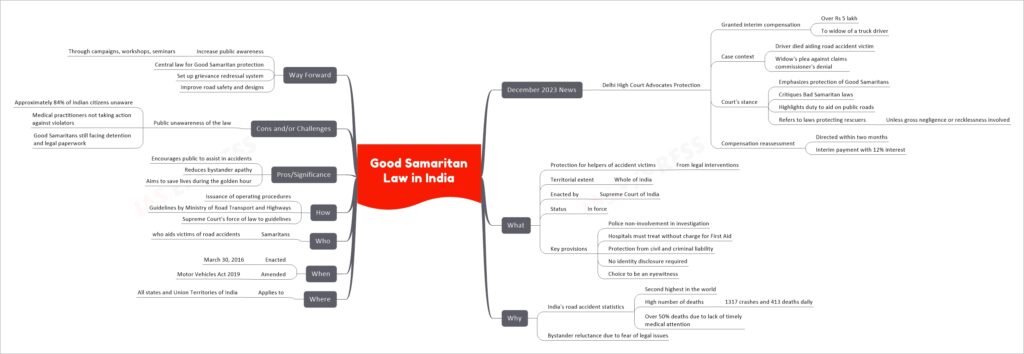Good Samaritan Law in India: Provisions, Pros, Challenges
The Delhi High Court recently granted interim compensation of over Rs 5 lakh to the widow of a truck driver who died while aiding a road accident victim. The case came into the limelight when the widow filed a plea against the claims commissioner’s denial. The court’s stance was clear and firm. It emphasized the protection of Good Samaritans and critiqued the so-called Bad Samaritan laws. The court highlighted the duty of citizens to aid on public roads and referred to laws protecting rescuers, unless there is evidence of gross negligence or recklessness involved. The court also directed a reassessment of the compensation within two months, with an interim payment that includes a 12% interest.
This topic of “Good Samaritan Law in India: Provisions, Pros, Challenges” is important from the perspective of the UPSC IAS Examination, which falls under General Studies Portion.
What is the Good Samaritan Law?
The Good Samaritan Law in India provides protection for helpers of accident victims from legal interventions. The law has a territorial extent that covers the whole of India and was enacted by the Supreme Court of India. As of now, the law is in force.
Key provisions of the law include:
- Police non-involvement in the investigation
- Hospitals must treat without charge for First Aid
- Protection from civil and criminal liability
- No identity disclosure required
- Choice to be an eyewitness
Why was the Good Samaritan Law Enacted?
India’s road accident statistics are alarming, with the country having the second-highest number of road accidents in the world. Daily, there are 1317 crashes and 413 deaths. Over 50% of these deaths occur due to a lack of timely medical attention.
One of the main reasons for the enactment of the Good Samaritan Law was the reluctance of bystanders to help accident victims due to fear of legal issues.
Where does the Good Samaritan Law Apply?
The Good Samaritan Law applies to all states and Union Territories of India.
When was the Good Samaritan Law Enacted and Amended?
The Good Samaritan Law was enacted on March 30, 2016. It was later amended in the Motor Vehicles Act 2019.
Who are the Samaritans?
In the context of the Good Samaritan Law, Samaritans are individuals who aid victims of road accidents.
How was the Good Samaritan Law Implemented?
The Good Samaritan Law was implemented through the issuance of operating procedures and guidelines by the Ministry of Road Transport and Highways. The Supreme Court gave force of law to these guidelines.
The Significance of the Good Samaritan Law
The Good Samaritan Law encourages the public to assist in accidents, thereby reducing bystander apathy. The law aims to save lives during the golden hour, which is the first hour after a traumatic injury when emergency treatment is most likely to be successful.
Challenges of the Good Samaritan Law
Despite its significance, the Good Samaritan Law faces several challenges. Approximately 84% of Indian citizens are unaware of the law. Medical practitioners often do not take action against violators, and Good Samaritans still face detention and legal paperwork.
The Way Forward
To overcome these challenges, it is crucial to increase public awareness through campaigns, workshops, and seminars. A central law for Good Samaritan protection should be established, and a grievance redressal system should be set up. Additionally, road safety and designs should be improved.
Conclusion
The Good Samaritan Law in India is a significant step towards encouraging public participation in saving lives during road accidents. Despite the challenges, with increased awareness and legal support, the law holds the potential to bring about a significant change in the country’s road safety scenario.


